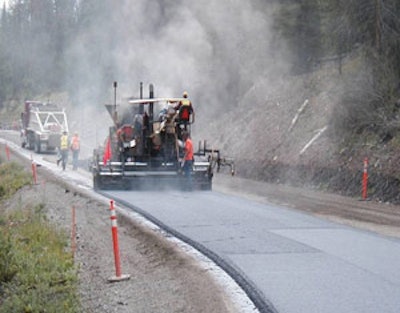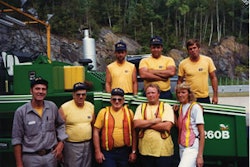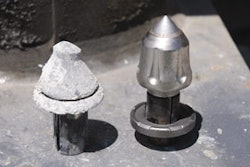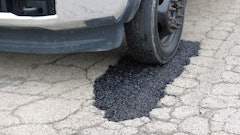
The future of hot mix asphalt might be cooling down a little bit...to warm mix asphalt. Warm mix asphalt (WMA) is an asphalt mix with an additive that allows the asphalt to be mixed and placed at cooler temperatures, says Annette Smith, project leader, Warm Mix Asphalt Technology Group, PQ Corp. "Not cold temperatures but usually between 50°F to 75°F cooler than you would typically make a hot mix asphalt," she says.
The background
Warm mix asphalt initially started in Europe but made its way over to the United States around 2003-2004, Smith says.
The benefits of WMA are numerous. First, and one of the main reasons warm mix asphalt was created, is lower emissions. "Depending on the type of emissions you can reduce it up to 65%," Smith says. "There are reductions in emissions not only at the plant where they manufacture the asphalt but also behind the paver."
Contractors who use WMA to pave also benefit from the ability for longer hauls -WMA asphalt does not have to be placed as quickly as hot mix asphalt (HMA) - as well as the opportunity to place WMA in cooler temperatures. Being able to work in cooler temperatures can allow contractors to pave later in their normal paving season.
The additives, or "technologies," added to WMA reduce the amount of oxidation of the asphalt binder which creates a longer life for the pavement, Smith says. Another benefit is that warm mix asphalt acts like a compaction aid providing improved compaction or density with different mixes, she adds.
Warm mix asphalt also benefits the asphalt plants with reduced fuel costs, Smith says. "Because material is being placed at lower temperatures, fuel usage is decreased at the asphalt plant," she says. "Fuel savings changes depending on the mix design, but people have quoted anywhere from 10% to 30% fuel savings, which nowadays is becoming even more of an issue."
There is also the opportunity to benefit from combining reclaimed asphalt pavement (RAP) with warm mix asphalt, Smith says. The lower temperatures of WMA allow plants to include higher amounts of RAP in their mixes. Higher RAP amounts can help save costs and allow asphalt plants to use less virgin asphalt binder.
Perhaps the biggest benefit paving contractors can reap from the use of WMA is a better "quality of life" while on the job. When paving with WMA no black smoke is produced, Smith says. This means contractors won't get as dirty and will breathe less fumes. And since WMA is not as hot as HMA, the workers walking behind the paver or doing hand work have a less likely chance to get burns from the asphalt. Along with that, WMA gives off less heat, which is good for working in hot environments.
The technologies
When WMA first took off in the U.S., there were three technologies available to add to HMA to lower its temperature, Smith says. Those three technologies were Advera, Evotherm, and Sasobit. It is important to note that the technologies used to create WMA are either added to the mix at the asphalt plant or at the terminal. None of the technologies can be added after the mix leaves the plant, Smith says.
Advera, a synthetic zeolite, is a mineral filler with a small amount of moisture. That moisture is emitted when the filler comes in contact with heat and lowers the mix's temperature. Evotherm has several technologies, some with water and some without water, which changes the binder to flow at lower temperatures. Sasobit is a wax that mixes with the binder and chemically changes the mix to create greater workability, Smith says.
These three technologies have been around in the United States since 2004 and have been widely tested, she says. But they aren't the only technologies available in today's market to create warm mix asphalt. To learn more about the current technologies visit www.warmmixasphalt.com or the Federal Highway Administration's website (www.fhwa.dot.gov).
The future
Since its introduction to the U.S. in 2004, warm mix asphalt has grown and changed. According to Smith, in 2004 there were only a few demonstrations done on only small areas. Now, more demos are being done and WMA is being used on larger, more "major" jobs. "The volume is getting much larger and the jobs are getting more high profile. The DOTs are starting to write change orders into their projects." New technologies are continually being created for the market as well.
Smith says she is seeing more people becoming interested in using warm mix asphalt. As a result, WMA is becoming much more widely accepted. But WMA is still in its infancy, and Smith sees even more growth in the future.
"There have been comments made that in 10 years all they'll be talking about is warm mix; there won't be hot mix anymore," Smith points out. "I don't know if that's going to be true or not, but I would say that the pace is moving so quickly and the benefits are so great that you really could see warm mix being the majority of the asphalt that's being paved in 10 years."
Smith expects to see even more technologies created in the next five to 10 years as well. Standardized testing of new technologies will be needed to qualify them as legitimate technologies. And she says she expects the marketing of WMA to grow as well in the future.
The cost
With the rising cost of fuel, asphalt plants as well as pavement and pavement maintenance contractors are looking for ways to reduce their costs. Smith mentioned some of the important cost saving benefits of WMA. But what does it cost to produce and use WMA? "It's so dependent upon the technology and what they're using it for," Smith says. Some small jobs using WMA may be higher in cost than with HMA, but if plants can use additional RAP and reduce fuel, they should be able to have a cost benefit from WMA.
All the other benefits of WMA may outweigh a higher cost for some jobs. And contractors who are looking down the road into the future may not want to just brush off WMA.
"I just think it's really the future of asphalt," Smith says. "Every time that there's a project that's done [with WMA] it seems like another benefit is found for this technology. There's a lot of enthusiasm in the industry for it, and it's really going to be the wave of the future."
Paving of the Future: Warm Mix Asphalt and Porous Asphalt Pavement
Contractors interested in learning more about new pavement technologies can attend the Paving of the Future seminar at the 2009 National Pavement Expo, Feb. 18-21, in Charlotte, NC. Annette Smith, PQ Corporation, and Andrew Potts, P.E., Cahill Associates, will discuss both warm mix asphalt and porous asphalt pavement. You'll learn how the materials are similar to traditional hot mix asphalt, how they act differently, and what you need to know as contractors when bidding and constructing pavements involving these technologies.
For more information visit www.nationalpavementexpo.com.











![Lee Boy Facility 2025 17 Use[16]](https://img.forconstructionpros.com/mindful/acbm/workspaces/default/uploads/2025/09/leeboy-facility-2025-17-use16.AbONDzEzbV.jpg?ar=16%3A9&auto=format%2Ccompress&fit=crop&h=135&q=70&w=240)








